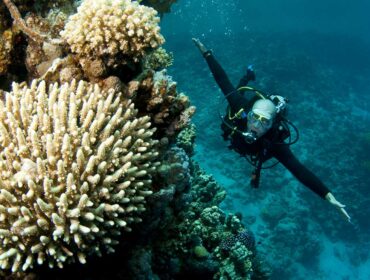If you can’t beat them, join them. This is what started off the thrilling drift dive which makes the currents work for you instead of against you. There is nothing more exhilarating than to be shot off along a strong current and watch the reef pass you by as you sail along effortlessly. It’s almost the equivalent of sky diving underwater.
Here are a few pointers that will help you enjoy drift diving even more and make it a little safer as well.
1. Follow the three ‘S’ of drift diving: Surface float, Surface Supervision and Safety Sausage
The best way to drift dive is to appoint a line handler and trailing a surface float while you dive that can be trailed by the dive boat above. This allows for an easy pick up at the end of the dive, and allows the group to dive greater distances riding the current. The surface float is especially helpful diving in newer waters where the boatman may be unfamiliar with the currents.
Whether you drift dive with a surface float line or not, it is essential that you have surface supervision on a drift dive, that can spot the divers on the surface and bring the boat around for retrieval. The surface supervision team also spots and picks up any divers that detach from the group, and have to ascend to the surface.
All divers on a drift dive should carry a safety sausage or a deployable high visibility buoy that can help the dive boat spot you should you separate from the group and have to surface. A whistle attached to your BCD might help as well in such a situation.
2. Watch that Depth Gauge like a hawk.
Once you’re riding the fast currents, it is really difficult to monitor your depth. Divers can be carried upwards or downwards at great speed depending on the strength of the current. This can be dangerous if you are diving in deeper waters, and a nightmare if you have trouble equalizing. Set your dive computers to drift mode if they have the setting, which alerts you with a series of audible beeps It is always advisable to drift dive in shallower waters, where you can use the terrain as a reference guide and keep a constant check on your depth gauge.
3. Hug the Bottom
The current is almost always lesser at the bottom near the sea bed, so if you need to slow down or wait for the group to catch up with you, go lower and hug the bottom. Some divers use their scuba knifes to gain purchase to the sea bed if there are no rocky outcrops to grab hold of. While descending, a quicker decent to the bottom will give you a bit of time to regroup. Those that take longer to descend or have trouble equalizing will get carried away by the stronger currents at the top so watch your buddy closely and stay together at all times.
4. Go with the flow, not against it
I guess this is one of the most common tip for drift diving, but somehow several divers still choose not to accept it. Currents can create psychological stress for divers who aren’t used to them , which often cause divers to swim against or fight the current which is an almost natural instinct. This however can lead to exhaustion, and rapid air depletion. Once you learn to go with the flow, you quickly realize that there is no need to even use your fins, other than to correct course, and you can dive for longer and cover much greater distance on a single tank of air.
5. Drift dive in good visibility only
Moving at high speeds along a reef in poor visibility poses a risk of running smack into something. I know its difficult to have clear water where there are currents, but check for relatively clear visibility just enough to allow you to anticipate and take evasive maneuvers whenever something looms up ahead. Poor visibility can also make it hard for the group to stay together, which is critical on a drift dive. Losing a buddy and having to meet up at the surface is extremely challenging in strong currents, so make you can maintain at least visual contact with everyone in your group.


